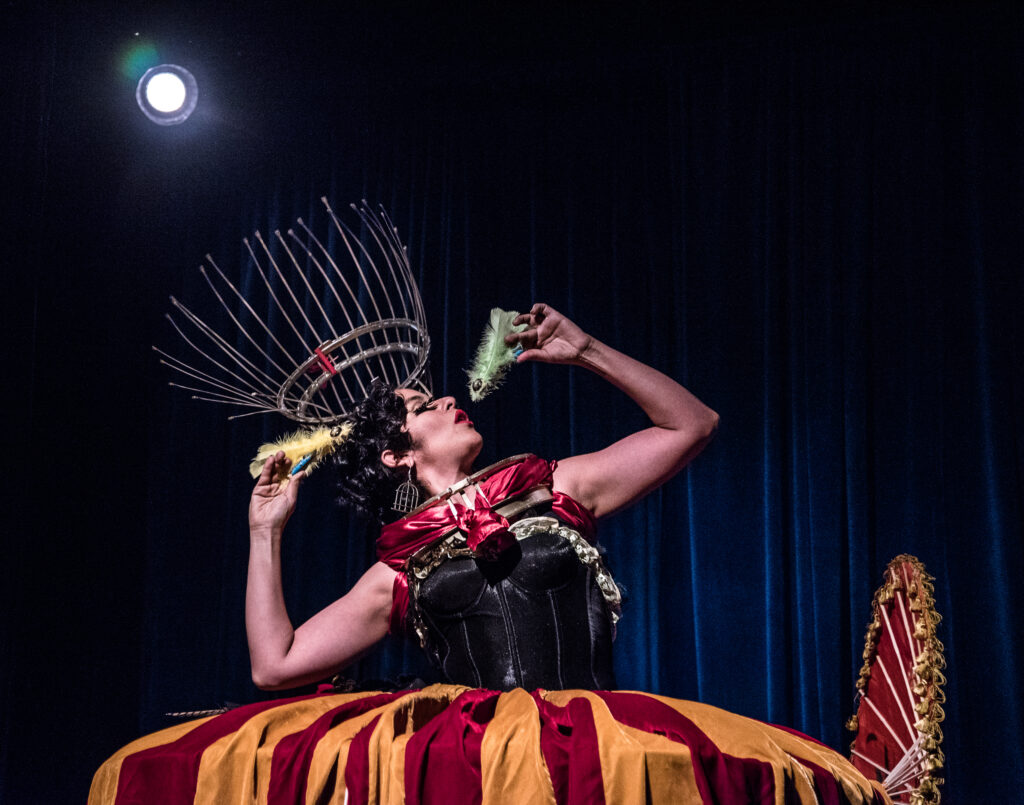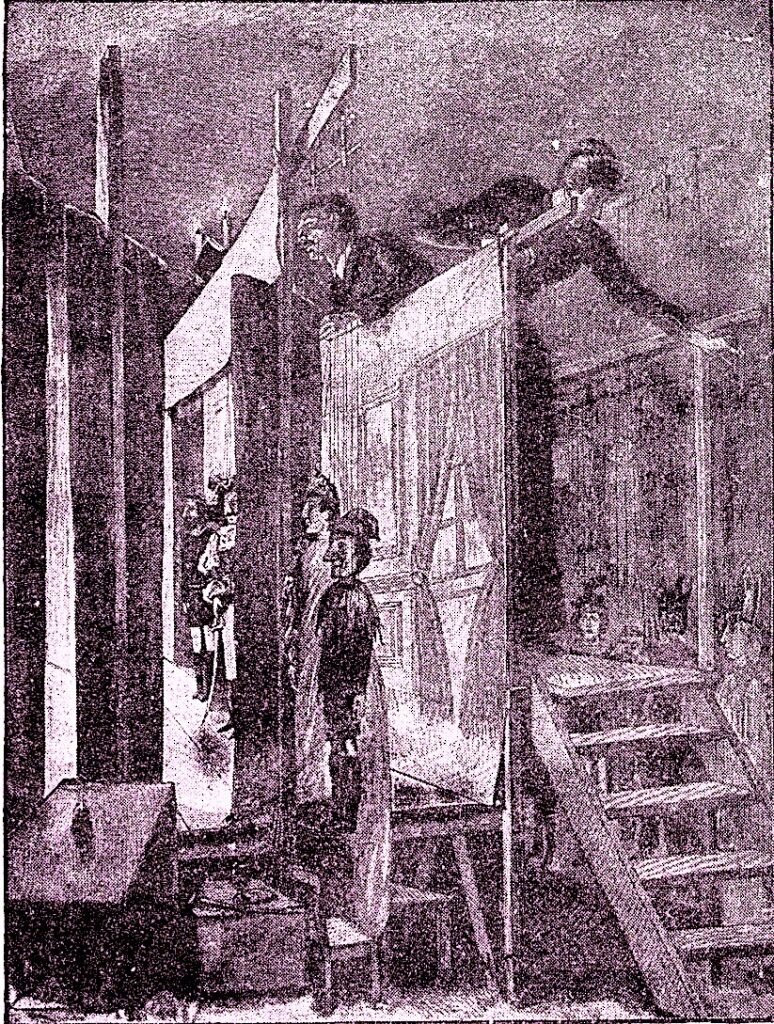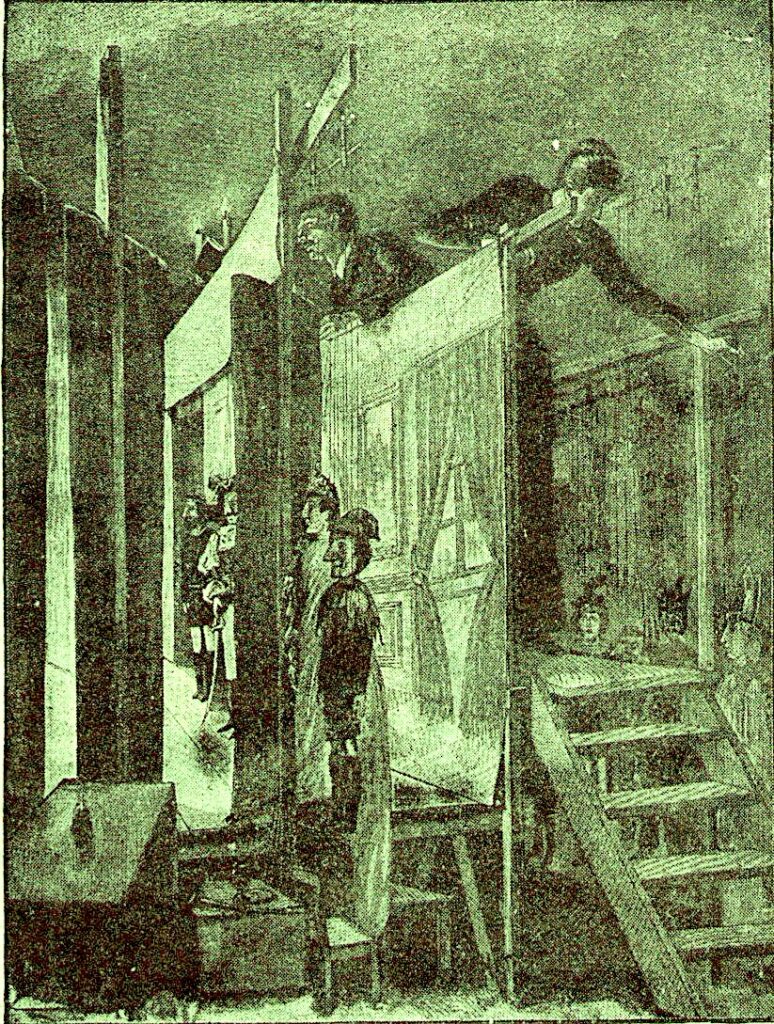Entrevista a Elvia Mante sobre el proyecto Mujeres en el arte de los títeres, realizada por Comba Campoi para la Revista Monicreques, Galicia
Entrevista Elvia Mante 105 erregue té – Revista Galega de Teatro r
Español e Inglés
Bajo el manto del discurso hegemónico, donde las subalternidades pudieron construir lo que Michel de Certeau llamó artes cotidianas, florecieron diversos mundos poéticos y artísticos. Parece innecesario recordar que el hecho de que en los relatos históricos sólo se incluyan creadores masculinos, heterosexuales y no racializados, no significa que no hubo creación en los márgenes. Es trabajo de investigadores y creadores conscientes asumir ese rastreo del pasado y evitar ese sesgo en los registros del presente.
En el ámbito del teatro de títeres, objetos o formas animadas, el silenciamiento es quizás más acusado que en otros, por su carácter popular y subalterno, apenas merecedor de la atención de los cronistas de su época. John McCormick y Bennie Pratasik, que investigaron las huellas de los titiriteros populares de la Europa del siglo XIX, se refirieron a las titiriteras como parte de compañías itinerantes de tipo familiar, siempre bajo el control del marido. El irrepetible Henrique Delgado, titiritero y etnógrafo de títeres portugueses del siglo XX, capta la habilidad de Clarinda de Azevedo, quien se hizo cargo de la manipulación del Teatro Dom Roberto Valente cuando su marido no podía actuar físicamente. En Galicia, desde la Asociación Morreu o Demo se ha podido saber que Julia, la hermana mayor de José Silvent, manipulaba con solvencia el teatrito que tenía junto al cuartel de su marido, payaso de profesión. Y a pesar de la existencia de estos y otros precursores, las propias titiriteras
todavía sienten que se están aventurando en un mundo que les es ajeno. Para luchar contra esta percepción, Elvia Mante ha iniciado una titánica labor de recopilación y difusión que puede consultarse en su página mujeresenelar-tedelositeres.com. En la pasada edición del Titi-riberia pudimos contar con su participación por videoconferencia y ahora hablamos con ella vía email.
Under the mantle of the hegemonic discourse, where subalternities were able to build what Michel de Certeau called everyday arts, diverse poetic and artistic worlds flourished. It seems unnecessary to remember that the fact that only male, heterosexual and non-racialized creators are included in the historical accounts, does not mean that there was no creation on the margins. It is the work of conscious researchers and creators to take on that tracing of the past and avoid that bias in the records of the present.
In the field of the theater of puppets, objects or animated forms, silencing is perhaps more pronounced than in others, due to its popular and subaltern character, hardly deserving of the attention of the chroniclers of its time. John McCormick and Bennie Pratasik, who researched the traces of the popular puppeteers of 19th century Europe, referred to female puppeteers as part of itinerant family-type companies, always under the control of the husband. The unrepeatable Henrique Delgado, puppeteer and ethnographer of Portuguese puppets in the 20th century, captures the skill of Clarinda de Azevedo, who took over the manipulation of the Dom Roberto Valente Theater when her husband was physically unable to perform. In Galicia, from the Asociación Morreu o Demo it has been gathered that Julia, the older sister of José Silvent, manipulated with solvency the little theater that she had together with the barrack of her husband, a clown by profession. And despite the existence of these and other precursors, the dollhouses themselves they still feel like they are venturing into a world that is alien to them. To fight against this perception, Elvia Mante has started a titanic collection and dissemination work that can be consulted on her page mujeresenelar-tedelositeres.com. In the last edition of the Titi-riberia we were able to count on her participation by video conference and now we talk to her via email.
Cuáles pueden ser las razones de que se siga considerando que el sector del teatro de objetos es mayoritariamente masculino? Fue historicamente el teatro de títeres “cosa de hombres”, como las distintas historias de las marionetas insisten en afirmar?
La historia se ha escrito desde una perspectiva masculina, en ella no aparecemos las mujeres, salvo algunos casos excepcionales y solo recientemente debido al auge que ha tenido la revisión de la Historia con perspectiva feminista. En todos los campos de la cultura somos las mujeres las que estamos recorriendo el velo que nos ha mantenido ocultas y estamos demostrando a fuerza de trabajo y horas invertidas, que nuestras aportaciones a la cultura no han sido anomalías, o excepciones, sino intentos machistas y patriarcales concientes o inconcientes, por borrarnos de la misma. “Nunca más tendrán la comodidad de nuestro silencio” dice por ahí una consigna feminista. Yo al menos estoy contribuyendo en esta empresa colosal que significa visibilizarnos a través de censos que desmienten la aseveración de que el teatro de títeres es cosa de hombres. Censarnos y ubicar la información en una página al alcance de cualquiera interesado en el tema es uno de los caminos, el que yo elegí para ello.
Comba Campoi: Cómo surge la idea de elaborar un censo de mujeres titiriteras en el mundo?
He realizado tres censos de mujeres relacionadas con el arte de los títeres: 2007, 2014 y 2021. Surgieron como una respuesta a comentrios machistas sobre nuestra presencia -no digamos aportaciones- a nuestra profesión. La primera vez, en un congreso de UNIMA México, donde mas de la mitad de las personas presentes eramos mujeres, mencioné mi inquietud por saber cuantas seríamos en el país y la respuesta de un veterano y prestigiado titiritero fue ¿y habrá mujeres titiriteras?. A los siete días yo había reunido mas de cien nombres y lugares de residencia, así como fotografías de algunas de ellas. Fue una especie de censo informal cuyos resultados presenté en el Segundo Encuentro Títeres en femenino convocado ese mismo año por Concha de la Casa en Bilbao. Para el 2014 la UNIMA México se había reestructurado y yo propuse hacer una Comisión de Mujeres para tratar nuestras problemáticas y hacer un nuevo censo. Obtuve muchos cuestionamientos por parte de los varones, secundados por muchas mujeres, que veían esta iniciativa como un intento de dividir al gremio, como algo de poca importancia. Aún así con el apoyo de otra compañera, Tania Xochicale, hicimos un formulario que distribuímos por correo electrónico y del cual obtuve 140 respuestas. No es que fuéramos solo 140, es que el formulario era muy extenso y requería mucho trabajo y tiempo para responderlo. Y no todas estamos dispuestas a ello. Hubiera sido un documento impresionante si la respuesta hubiera sido mayor, pero al menos nos proporcionó datos estadísticos interesantes.
Cabe aclarar que estos dos primeros censos estaban enfocados en las artistas escénicas, es decir titiriteras, animadoras, manipuladoras, como quieran llamarse, aún y cuándo con sus respuestas constatamos que nuestras aportaciones son en múltiples ámbitos, “todólogas” decíamos por entonces, “renacentistas”comencé a llamarlas yo.
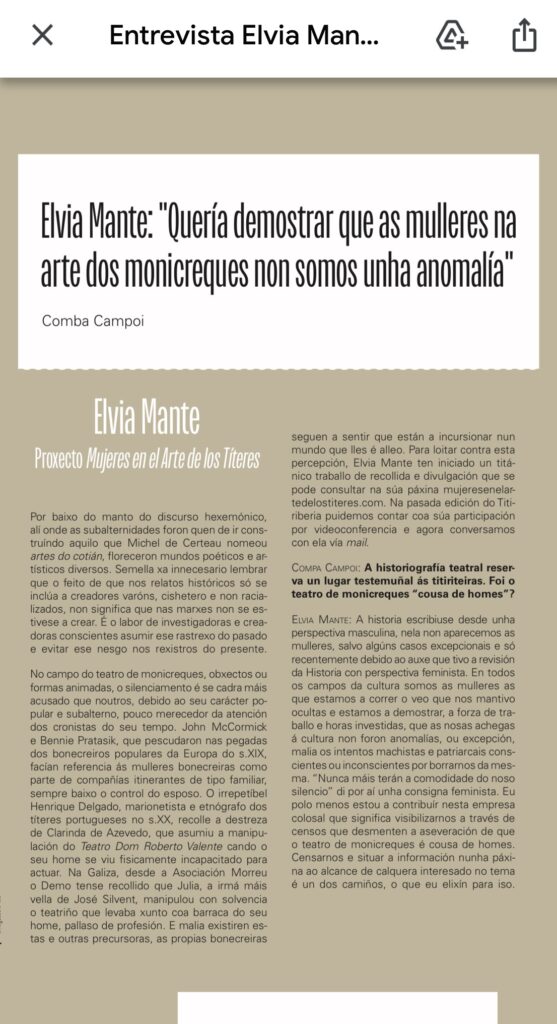
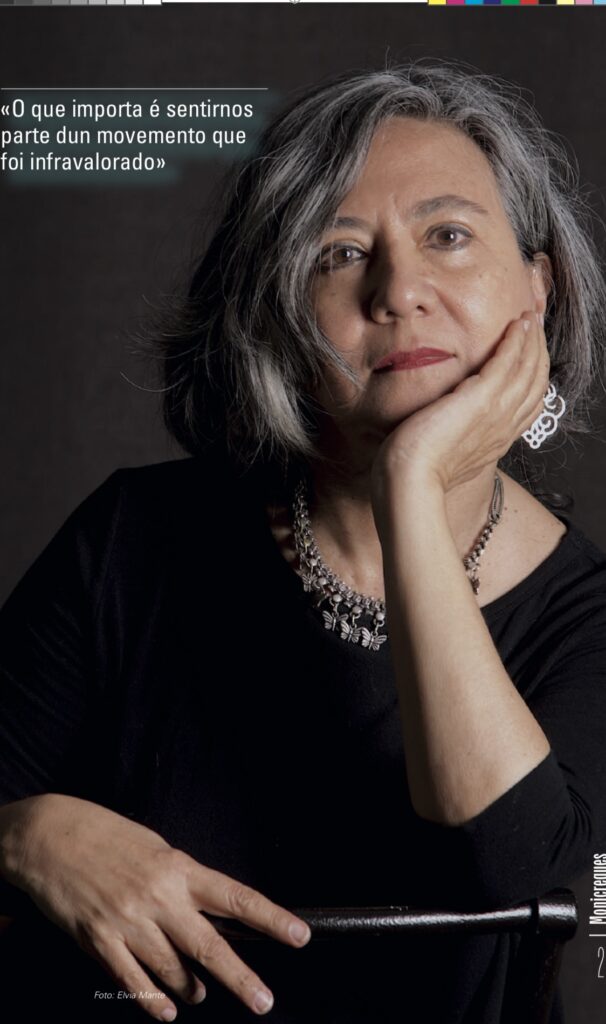
Translation by Google
What could be the reasons why the object theater sector continues to be considered predominantly male? Was puppet theater historically “a man’s thing,” as the various puppet stories insist on affirming?
History has been written from a male perspective, women do not appear in it, except in some exceptional cases and only recently due to the rise of the revision of History with a feminist perspective. In all fields of culture, we women are the ones who are covering the veil that has kept us hidden and we are demonstrating by dint of work and hours invested, that our contributions to culture have not been anomalies, or exceptions, but sexist attempts and conscious or unconscious patriarchal, to erase us from it. “They will never again have the comfort of our silence” says a feminist slogan. At least I am contributing to this colossal undertaking that means making ourselves visible through censuses that deny the assertion that puppet theater is a man’s thing. Taking a census and placing the information on a page accessible to anyone interested in the topic is one of the ways, the one I chose for this.
Comba Campoi: How did the idea of preparing a census of women puppeteers in the world come about?
I have carried out three censuses of women related to the art of puppetry: 2007, 2014 and 2021. They emerged as a response to sexist comments about our presence – let alone contributions – to our profession. The first time, at a UNIMA Mexico congress, where more than half of the people present were women, I mentioned my concern about knowing how many there would be in the country and the response of a veteran and prestigious puppeteer was, «And will there be women puppeteers?» Within seven days I had gathered more than a hundred names and places of residence, as well as photographs of some of them. It was a kind of informal census whose results I presented at the Second Women’s Puppet Meeting convened that same year by Concha de la Casa in Bilbao. By 2014, UNIMA Mexico had restructured and I proposed creating a Women’s Commission to address our problems and conduct a new census. I received many questions from the men, supported by many women, who saw this initiative as an attempt to divide the union, as something of little importance. Even so, with the support of another colleague, Tania Xochicale, we made a form that we distributed by email and from which I obtained 140 responses. It’s not that there were only 140 of us, it’s that the form was very long and required a lot of work and time to answer. And not all of us are willing to do that. It would have been an impressive document if the response had been higher, but at least it gave us interesting statistical data.
It is worth clarifying that these first two censuses were focused on performing artists, that is, puppeteers, entertainers, manipulators, whatever you want to call themselves, even when with their answers we verify that our contributions are in multiple areas, «everything» we said at that time, «renaissance ”I started calling them.
El tercer censo que he decidido sea permanente surgió también como una respuesta visceral a dos situaciones, la primera fue porque al utilizar un motor de búsqueda en internet para la palabra “titiritera” este me respondión con la pregunta “¿quieres decir titiritero?” como si la “o” fuera inclusiva de nuestro sexo. Y esto lo hizo una y otra vez. Como prueba me fui a la búsqueda de imágenes, el masculino arrojaba montones de rostros de hombres, pero el femenino apenas mostraba unas cuántas. Esto aunado a un artículo escrito por un varón que decía “la presencia de las mujeres en el arte de los títeres ha sido una anomalía” me llevó primero a crear un grupo de facebook para censarnos: Mujeres en el arte de los títeres y lancé la invitación. Las primeras respuestas fueron de Puerto Rico y Brasil y esto me dio la pauta para convertirlo en un censo no solo de titiriteras mexicanas como los dos primeros, sino abrirlo a un contexto internacional y hacerlo inclusivo no solo de artistas escénicas sino también dramaturgas, directoras, productoras, diseñadoras, investigadoras, etc.
La rápida y amplia respuesta me permitió darme cuenta que un grupo de facebook no era lo más apropiado para un censo, por la misma dinámica de los algoritmos, los likes, las fechas, la información fácilmente desaparecía y no era fácil consultarla o visualizarla, así que armé una fan page también en facebook con el mismo nombre Mujeres en el arte de los títeres, que me permitiera crear albumes de fotografías por países principalmente y armé un pequeño cuestionario que me permitiera obtener respuestas de manera ordenada. Finalmente descarté los albumes por países y armé una sola carpeta que a primera vista nos permitiera saber cuántas mujeres estaban participando y demostrar que no éramos una anomalía, ni en el pasado, ni ahora.
El siguiente paso fue comprar un dominio con el mismo nombre Mujeres en el arte de los títeres, y diseñar una página web que me permitiera ahora si clasificar por países, y en el caso de México, por Estados, y anexar a cada fotografía el formulario, para de esta manera ofrecer una oportunidad para usarla como consulta o directorio, según el interés de los usuarios.
Todo este proceso lo realicé durante 4 meses por mi cuenta, y recopilé información de 300 mujeres. A finales de Marzo del 2022 obtuve un apoyo estatal del Sistema Nuevo León para el impulso artístico y la creación, para realizar varias actividades artísticas y continuar con el censo. Dicho apoyo terminó en Marzo del 2023 con un total de 772 mujeres incluídas. Vale aclarar que el entusiasmo inicial disminuyó considerablemente y han dejado de enviar fotos o formularios, así que me he enfocado en nutrir el censo investigando nombres e historias de “mujeres que abrieron camino, mujeres que dejaron huella”, como un homenaje. Esto también ha arrojado datos interesantes: mujeres dueñas de compañías o mujeres titiriteras que ejercían la profesión -así consta en archivos históricos oficiales- en el Siglo XVII en España y Perú, por ejemplo.
Este proceso es más lento, pues la pesquisa en las redes proporcionan un encadenamiento de información que me llevan a nuevos descubrimientos. Es un camino apasionante pero que requiere más horas de las que puedo comprometerme sin afectar mi propio trabajo artístico y de gestoría dentro de mi compañía Baúl Teatro.
Comba Campoi: Cómo se financia el proyecto; tienes apoyo de alguna institución o entidad?
Los dos primeros censos y los primeros meses de este los realicé totalmente sin apoyo, empecé a realizar este trabajo sin apoyo económico, en mis tiempos libres. La beca que obtuve en Marzo del 2022 fue solo un apoyo parcial para el censo ya que además contemplaba la dramaturgia y puesta en escena de un espectàculo de cachiporra con protagonista femenina, el cual recién estrenamos, además de escribir un ensayo e impartir conferencias sobre el censo y sus avances.
Descríbenos la respuesta que está teniendo tu página y el censo. Entre las titiriteras gallegas la acogida ha sido muy buena, lo que crea la sensación -entiendo que falsa- de que en Galicia hay muchas más titiriteras que en otros lugares del mundo.
Yo considero que los censos son importantes porque nos permite visibilizarnos y encontrarnos. Por el momento no importa que nuestra percepción sea falsa, me refiero al caso de Galicia que mencionas o de cualquier otro lugar, lo que importa es sentirnos parte de un movimiento que ha sido infravalorado. Este censo no es definitivo ni preciso, es solo una ventana para vislumbrarnos, saber que somos muchas, que hubo quiénes nos facilitaron las cosas por su sola presencia siglos o años atrás, reconocer que nos han borrado de la historia, que los hombres y mujeres que escribieron nuestra historia, al no hacerlo con perspectiva femenina/feminista obviaron datos importantes, de tal modo que siguen considerando que el arte de los títeres es una profesión masculina y que así ha sido solo porque nuestros nombres no aparecen en sus investigaciones. Tan es así, la falta de perspectiva femenina/feminista y la creencia de que no fuimos parte de nuestra historia, que hasta investigadores eruditos mencionan a la Abadesa Herrad de Landsberg como un abate. Ella fue la autora de la imagen mas antigua de Alemania y de Europa sobre el arte de los títeres la cual incluyó en la enciclopedia El Jardín de las Delicias, la primera hecha por una mujer, en la cual trabajó por mas de 30 años con el apoyo de 60 monjas cuyos retratos y nombres fueron incluidos como diciendo “Aquí estamos, nosotras fuimos quienes hicimos ese libro”. Como digo, la falta de perspectiva y el anclaje en creencias machistas son los que han borrado nuestros nombres de la historia.
Comba Campoi:Si el teatro de objetos y marionetas es un sector especialmente precarizado dentro de las artes escénicas, lo es doblemente para las mujeres. Cuáles son los obstáculos que encuentran las mujeres que deciden dedicarse profesionalmente al teatro de títeres? Consideras que es un sector machista o que discrimina a las mujeres?
En Julio del 2022 realicé un encuentro en línea de mujeres titiriteras dentro del XXIX Festibaúl de títeres que organiza mi compañía en Monterrey, N.L. Las mujeres que participaron tenía que enviar una ponencia escrita y un video donde hablaran desde el YO, MUJER, sobre sus experiencias dentro de la profesión. (Estos videos pueden consultarse en la página de Youtube baul2010) Las ponencias recibidas junto con las respuestas a los formularios, requieren un estudio exhaustivo que realizaré mas delante, cuándo alcance mi primer meta de 1000 mujeres censadas, pero por ahora me permiten vislumbrar un panorama no tan halagüeño: Muchas mujeres siguen “bajándose del peldaño para no tapar la luz a los hombres”, y esto lo hacen, entre otras cosas, quedándose en casa a cuidar de los hijos mientras crecen, o limitando sus oportunidades de participación en festivales o de mejores ingresos por tener que viajar con los hijos y en algunos casos pagar a alguien que les apoye en el cuidado mientras realizan su labor artística. Muchas coinciden en tener que lidiar con técnicos y funcionarios que las ignoran, a pesar de ser titiriteras o directoras, para dirigirse a los hombres como depositarios del saber pertinente para hacer los montajes en los espacios escénicos, si viajan sin la presencia de un compañero también suelen ser víctimas de acoso, y algunas incluso padecen el “síndrome de la impostora” y constantemente tienen que validar su presencia y aportaciones ante los demás, cosa que los varones dan por sentado sobre otros varones. Y esto puede apreciarse a simple vista. Recuerdo que en el censo del 2014 -e incluso en el actual, aunque no tan evidente- las mujeres se asumían como titiriteras y dejaban de lado sus aportaciones en promoción, dramaturgia, realización, diseño, dirección. Tuve que insisitir mucho a través de correos en el 2007 para que plasmaran por escrito todas sus aportaciones. Aún en este censo hay mujeres que conozco que realizan múltiples actividades, que solo se asumen como titiriteras, y hay otras que por no manipular o no construir, no se consideran “mujeres en el arte de los títeres” y no han querido participar en el censo.
A lo largo de tu trayectoria como titiritera profesional has asumido disintos roles: dramaturgia, manipuladora, productora distribuidora… Será que esa cualidad de asumir tantas responsabilidades, que nos inculcan a las mujeres, nos frena a la hora de desarrollar nuestras carreras profesionales? Será que acabamos siendo las artífices en la sombra, dejando a nuestros compañeros hombres destacar en las facetas más prestigiadas, más visibles, más vinculadas con lo creativo?
No creo que asumir distintos roles nos frena, en mi caso incursionar en tantos aspectos de nuestro arte ha sido muy enriquecedor, cada rol fue una oportunidad para aprender y crecer como artista, actualmente mis favoritos son la dramaturgia, la dirección y la investigación, y cada uno de ellos me ha obligado a prepararme. Lo que si tengo claro es que ante los ojos de los demás, no importa cuántos roles ejerza, cuántas obras haya dirigido (más de 60), cuantos libros de dramaturgia me hayan publicado, cuantas becas o premios haya ganado, he sido percibida -sobre todo dentro del gremio- como “la ayudante”. Aclaro: mi esposo es un excelente titiritero y disfruta mucho estar en escena, esto le permite ser visto y por ende que los demás asuman que él es el creativo principal, el artista, y yo la esposa que lo acompaña y “que le apoya en lo técnico”. Y mi caso no es el único, conozco compañías donde las mujeres dirigen y/o escriben mientras los hombres actúan, y todas confiesan haber pasado por lo mismo: ser ignoradas, asumir que los hombres, por ser los que están en escena, son los creativos/dueños de la empresa.
Esa es una visión machista y misógina. Como lo es también centrar la reseña de un espectáculo en el encanto y la actuación de un hombre fuera del retablo cuando la mujer es la titiritera tras el mismo, como leí recientemente en un artículo sobre una compañía española.
Es llamativo que muchas titiriteras gallegas deciden aventurarse a crear sus compañías solistas o con otras mujeres, como fórmula para poder desarrollar sus carreras profesionales. Sucede lo mismo en otros lugares del mundo, según lo que estás recogiendo en tu censo?
Un dato que recogí cuando llevaba apenas 300 mujeres censadas arrojó que mas de 200 son o tienen espectáculos como solistas, aún así, esto no implica que sean dueñas de sus compañías por lo que otra pregunta en el formulario busca saber cuántas somos dueñas de grupo, porque ser dueña implica tomar decisiones creativas y administrativas. Este dato es más difícil de contabilizar, algunas mencionan que son parte de una compañía familiar o que son dueñas junto con sus parejas, pero no queda claro si realmente pueden tomar las decisiones de una dueña o jefe.
Cómo es la situación de las y los profesionales del teatro de objetos en México? Existen políticas de apoyo al sector, y políticas de acción positiva para apoyar a las mujeres titiriteras? Qué opinas de este tipo de medidas?
Desconozco si hay iniciativas puntuales de apoyo a mujeres titiriteras, existen 2 convocatorias nacionales destinadas específicamente al arte de los títeres, a nivel estatal se compite dentro del área de teatro, pero como dijo una prestigiada jurado en un concurso para participar en una muestra de teatro nacional “yo no se nada de títeres así que descalifico su espectáculo para ser seleccionado”
Lo que si sé es que el premio mas importante para el arte de los títeres, la Presea Rosete Aranda que otorga el gobierno de Tlaxcala desde 1993, le ha sido entregada a 20 hombres y 11 mujeres. Las cuotas de género deben cumplirse. No son un favor, son un derecho. Decir que las mujeres obtienen preseas u apoyos porque hay que cubrir cuotas de género también es misógino, es creer que no tenemos suficiente calidad como para recibirlas.

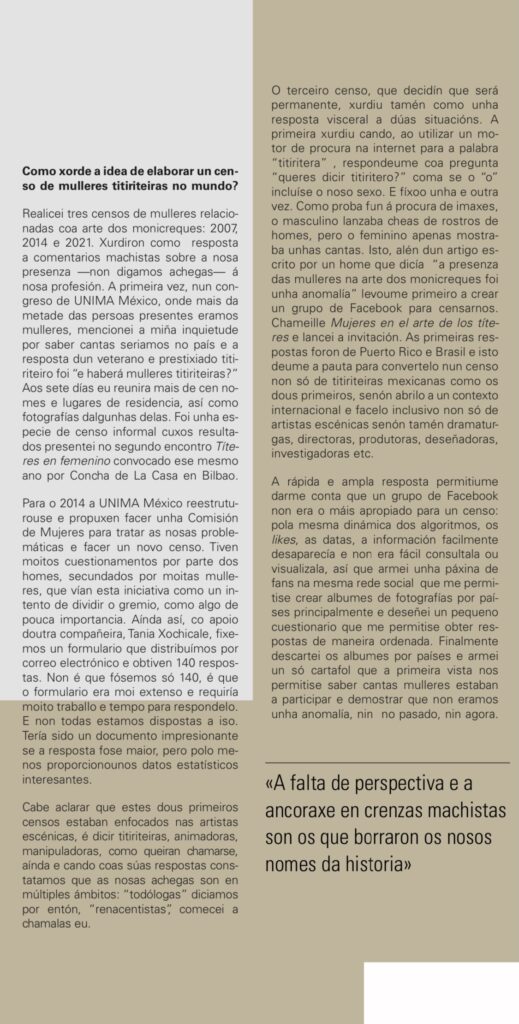
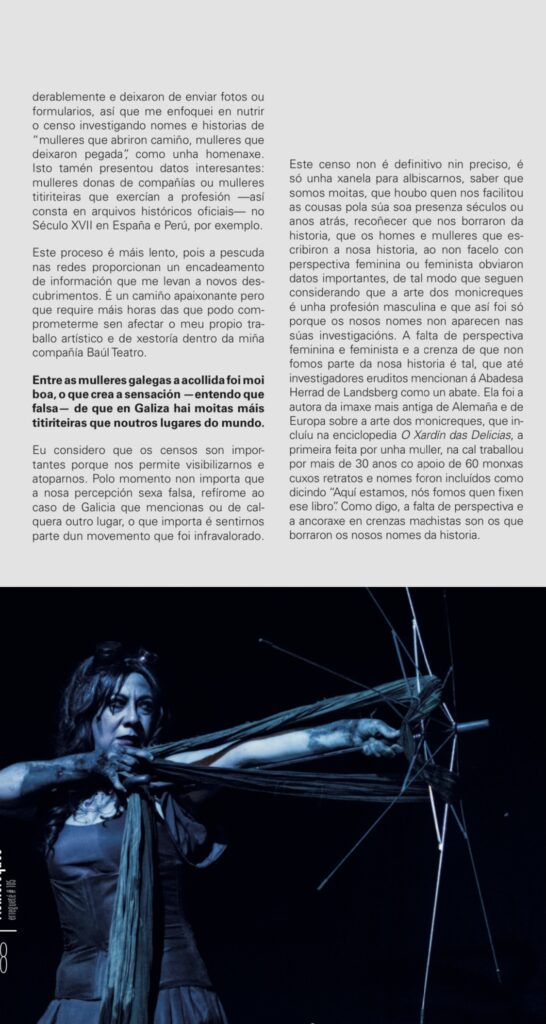
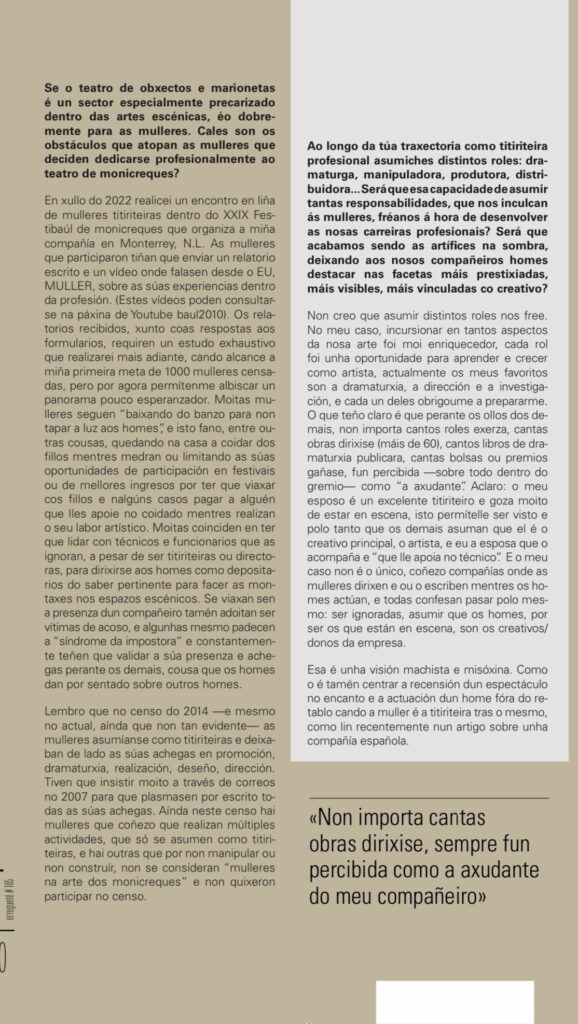

The third census that I have decided to be permanent also arose as a visceral response to two situations, the first was because when I used a search engine on the internet for the word “puppeteer” they responded to me with the question “do you mean puppeteer?” as if the “o” were inclusive of our sex. And this he did again and again. As proof I went to search for images, the male one showed tons of men’s faces, but the female one only showed a few. This, combined with an article written by a man that said «the presence of women in puppetry has been an anomaly» led me to first create a Facebook group to census us: Women in puppetry and I launched the invitation. The first responses were from Puerto Rico and Brazil and this gave me the guideline to turn it into a census not only of Mexican puppeteers like the first two, but to open it to an international context and make it inclusive not only of performing artists but also playwrights, directors, producers, designers, researchers, etc.
The quick and extensive response allowed me to realize that a Facebook group was not the most appropriate for a census, due to the same dynamics of the algorithms, the likes, the dates, the information easily disappeared and it was not easy to consult or view it, so I also created a fan page on Facebook with the same name Women in the art of puppetry, which would allow me to create photo albums by country mainly and I created a small questionnaire that would allow me to obtain answers in an orderly manner. Finally I discarded the albums by country and put together a single folder that at first glance would allow us to know how many women were participating and demonstrate that we were not an anomaly, neither in the past, nor now.
The next step was to buy a domain with the same name Women in the Art of Puppetry, and design a website that would now allow me to classify by country, and in the case of Mexico, by State, and attach the form to each photograph. , in order to offer an opportunity to use it as a consultation or directory, according to the interest of the users.
I carried out this entire process for 4 months on my own, and I collected information from 300 women. At the end of March 2022, I obtained state support from the Nuevo León System for artistic promotion and creation, to carry out various artistic activities and continue with the census. This support ended in March 2023 with a total of 772 women included. It is worth clarifying that the initial enthusiasm decreased considerably and they have stopped sending photos or forms, so I have focused on nurturing the census by researching names and stories of “women who paved the way, women who left their mark,” as a tribute. This has also yielded interesting data: women owners of companies or women puppeteers who practiced the profession – as recorded in official historical archives – in the 17th century in Spain and Peru, for example.
This process is slower, since research on networks provides a chain of information that leads to new discoveries. It is an exciting path but one that requires more hours than I can commit without affecting my own artistic and managerial work within my company Baúl Teatro.
Comba Campoi: How the project is financed; Do you have support from any institution or entity?
I carried out the first two censuses and the first months of this one completely without support, I began to carry out this work without financial support, in my free time. The scholarship I obtained in March 2022 was only partial support for the census since it also contemplated the dramaturgy and staging of a club show with a female protagonist, which we just premiered, in addition to writing an essay and giving lectures on the subject. census and its progress.
Describe to us the response that your page and the census are having. Among the Galician puppeteers the reception has been very good, which creates the feeling – I understand it is false – that in Galicia there are many more puppeteers than in other places in the world.
I consider that censuses are important because they allow us to make ourselves visible and find ourselves. For the moment it does not matter that our perception is false, I am referring to the case of Galicia that you mention or any other place, what matters is that we feel part of a movement that has been undervalued. This census is not definitive or precise, it is just a window to glimpse ourselves, to know that we are many, that there were those who made things easier for us by their mere presence centuries or years ago, to recognize that we have been erased from history, that men and women who wrote our history, by not doing it with a feminine/feminist perspective they ignored important data, in such a way that they continue to consider that the art of puppetry is a male profession and that this has been the case only because our names do not appear in their research. So much so, the lack of feminine/feminist perspective and the belief that we were not part of our history, that even scholarly researchers mention Abbess Herrad of Landsberg as an abbe. She was the author of the oldest image in Germany and Europe on the art of puppetry, which she included in the encyclopedia The Garden of Earthly Delights, the first made by a woman, on which she worked for more than 30 years with him. support of 60 nuns whose portraits and names were included as if to say “Here we are, we were the ones who made that book.” As I say, the lack of perspective and anchoring in sexist beliefs are what have erased our names from history.
Comba Campoi: If object and puppet theater is a particularly precarious sector within the performing arts, it is doubly so for women. What are the obstacles encountered by women who decide to dedicate themselves professionally to puppet theater? Do you consider it to be a sexist sector or one that discriminates against women?
In July 2022, I held an online meeting of women puppeteers within the XXIX Puppet Festival organized by my company in Monterrey, N.L. The women who participated had to send a written presentation and a video where they spoke from the perspective of ME, WOMAN, about their experiences within the profession. (These videos can be consulted on the baul2010 YouTube page) The presentations received, along with the responses to the forms, require an exhaustive study that I will carry out later, when I reach my first goal of 1000 registered women, but for now they allow me to glimpse an overview not so flattering: Many women continue to “get down the ladder so as not to block the light from men,” and they do this, among other things, by staying at home to take care of their children while they grow up, or by limiting their opportunities to participate in festivals or of better income for having to travel with their children and in some cases pay someone to support them in caring for them while they carry out their artistic work. Many agree on having to deal with technicians and officials who ignore them, despite being puppeteers or directors, to address men as repositories of the relevant knowledge to make the montages in the performing spaces, if they travel without the presence of a partner as well. They are often victims of harassment, and some even suffer from “imposter syndrome” and constantly have to validate their presence and contributions to others, something that men take for granted about other men. And this can be seen with the naked eye. I remember that in the 2014 census – and even in the current one, although not so evident – women were assumed to be puppeteers and left aside their contributions in promotion, dramaturgy, production, design, direction. I had to insist a lot through emails in 2007 for them to put all their contributions in writing. Even in this census there are women that I know who carry out multiple activities, who are only assumed to be puppeteers, and there are others who, because they do not manipulate or construct, do not consider themselves “women in the art of puppetry” and have not wanted to participate in the census.
Throughout your career as a professional puppeteer you have assumed different roles: playwright, manipulator, producer and distributor… Could it be that this quality of assuming so many responsibilities, which is instilled in us as women, stops us from developing our professional careers? Could it be that we end up being the creators in the shadows, leaving our male colleagues to stand out in the most prestigious, most visible, and most linked to creative facets?
I don’t think that assuming different roles stops us, in my case venturing into so many aspects of our art has been very enriching, each role was an opportunity to learn and grow as an artist, currently my favorites are playwriting, directing and research, and each one of them has forced me to prepare. What I am clear about is that in the eyes of others, no matter how many roles I play, how many plays I have directed (more than 60), how many playwriting books I have published, how many scholarships or awards I have won, I have been perceived – above all within the union – as “the assistant”. Let me clarify: my husband is an excellent puppeteer and he really enjoys being on stage, this allows him to be seen and therefore others assume that he is the main creative, the artist, and I am the wife who accompanies him and “supports him in the technical.” And my case is not the only one, I know companies where women direct and/or write while men act, and they all confess to having gone through the same thing: being ignored, assuming that men, because they are the ones on stage, are the ones creatives/business owners.
That is a sexist and misogynistic vision. As is also focusing the review of a show on the charm and performance of a man outside the altarpiece when the woman is the puppeteer behind it, as I recently read in an article about a Spanish company.
It is striking that many Galician puppeteers decide to venture into creating their solo companies or with other women, as a formula to develop their professional careers. Is the same thing happening in other places in the world, according to what you are collecting in your census?
A piece of information that I collected when I had only 300 women registered showed that more than 200 are or have shows as soloists, even so, this does not imply that they are owners of their companies, so another question on the form seeks to know how many of us are group owners, because being an owner involves making creative and administrative decisions. This information is more difficult to account for, some mention that they are part of a family company or that they are owners together with their partners, but it is not clear if they can really make the decisions of an owner or boss.
What is the situation like for object theater professionals in Mexico? Are there policies to support the sector, and positive action policies to support women puppeteers? What do you think of this type of measures?
I do not know if there are specific initiatives to support women puppeteers, there are 2 national calls specifically for the art of puppetry, at the state level there is competition within the theater area, but as a prestigious jury said in a contest to participate in a theater exhibition national “I don’t know anything about puppets so I disqualify your show from being selected”
What I do know is that the most important award for the art of puppetry, the Rosete Aranda Prize awarded by the government of Tlaxcala since 1993, has been awarded to 20 men and 11 women.
Gender quotas must be met. They are not a favor, they are a right. Saying that women get awards or support because gender quotas have to be met is also misogynistic, it is believing that we do not have enough quality to receive them.

